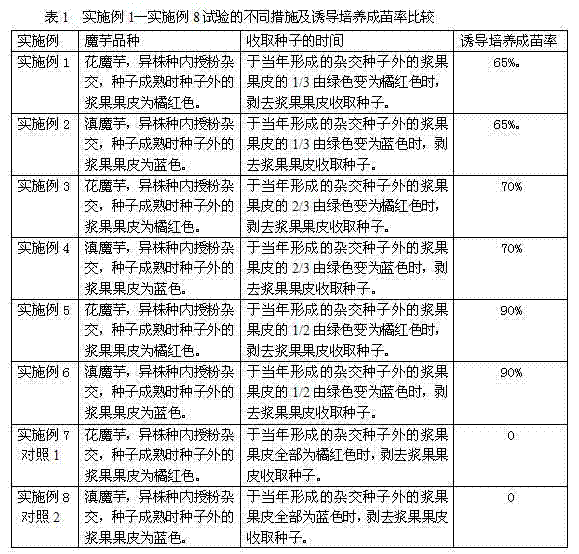Two-generation in one year reproduction method for konjac cross breeding
A hybrid breeding and hybrid seed technology, applied in horticultural methods, botanical equipment and methods, horticulture, etc., can solve problems such as slow breeding process, and achieve the effect of improving reproduction coefficient, speeding up breeding pace, and improving breeding efficiency
- Summary
- Abstract
- Description
- Claims
- Application Information
AI Technical Summary
Problems solved by technology
Method used
Image
Examples
Embodiment 1
[0013] The konjac used is flower konjac, which is pollinated and hybridized in different plants. When the seeds are mature, the berry peel outside the seeds is orange-red.
[0014] (1) the konjac is hybridized by conventional heterogeneous intraspecific pollination to form a hybrid, and when 1 / 3 of the berry pericarp outside the hybrid seed formed in the same year changes from green to orange red, the berry pericarp is peeled off to collect the seeds;
[0015] (2) Tissue culture the seeds collected in step (1) with the existing plant tissue culture method, and in the same year of step (1), plant rooted seedlings on the seedbed according to the conventional method, and perform seedbed management and single plant filter. Specifically, it can be carried out as follows:
[0016] Disinfect the seeds collected in step (1) with 70% alcohol surface for 2 seconds → sterilize with 0.1% mercuric chloride for 10 minutes → rinse with sterile water 3 times → inoculate under sterile condit...
Embodiment 7
[0023] When the seeds of Example 7 (Control 1) and Example 8 (Control 2) were induced and cultivated, the seedling growth rate was 0, so the follow-up test described in Example 1 could not be carried out, and the second-generation multiplication per year could not be realized. When all the berry peels of the seeds are orange-red or all blue, the fruit is ripe, and the seeds in it are mature seeds, which have entered the physiological dormancy period, and the seedling rate of using mature seeds to induce it is 0.
[0024] Above-mentioned experiment shows: will realize konjac crossbreeding one year two generation add generation propagation, shorten breeding process, the key is to select suitable period to collect seed, the seed that makes collection can be induced to differentiate into seedling, and the present invention selects in the year conventional crossbreeding to form The period when 1 / 3~2 / 3 of the berry pericarp outside the hybrid seeds changes from green to orange-red or...
PUM
 Login to View More
Login to View More Abstract
Description
Claims
Application Information
 Login to View More
Login to View More - R&D
- Intellectual Property
- Life Sciences
- Materials
- Tech Scout
- Unparalleled Data Quality
- Higher Quality Content
- 60% Fewer Hallucinations
Browse by: Latest US Patents, China's latest patents, Technical Efficacy Thesaurus, Application Domain, Technology Topic, Popular Technical Reports.
© 2025 PatSnap. All rights reserved.Legal|Privacy policy|Modern Slavery Act Transparency Statement|Sitemap|About US| Contact US: help@patsnap.com

